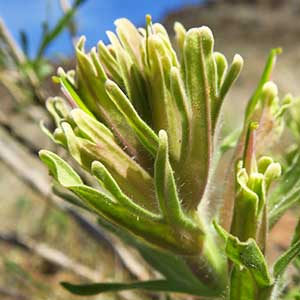Castilleja xanthotricha
Castilleja kaibabensis
John Day or yellow-hairy paintbrush, John Day paintbrush, yellow hair paintbrush, yellow-hair Indian paintbrush
Kaibab paintbrush, Kaibab Plateau Indian paintbrush
few to several, ± decumbent to erect or ascending, unbranched, sometimes with short, leafy axillary shoots, hairs erect to spreading, long, soft, eglandular, mixed with short stipitate-glandular ones.
solitary or few, sometimes several, erect or ascending, unbranched, rarely branched from base or from proximal inflorescence nodes, hairs spreading or reflexed, medium length, ± stiff, distally mixed with scattered, very short stipitate-glandular ones in inflorescences.
green, linear, lanceolate to broadly lanceolate, oblong, or cuneate, 0.8–5 cm, not fleshy, margins plane to wavy, involute, 0–5-lobed, apex acute, sometimes rounded;
lobes spreading, linear, arising below mid length, nearly as broad as center lobe, apex acute.
green, often with a dull red-purplish cast, linear to narrowly lanceolate or narrowly oblong, (0.8–)1.5–4 cm, not fleshy, margins plane, involute, 0(–3)-lobed, apex acuminate to acute;
lobes spreading-ascending, narrowly lanceolate, apex acute.
3–14 × 1.5–4.5 cm;
bracts proximally greenish, rarely dull reddish purple, distally white to cream, rarely pale yellow or dull, pale pink (sharply differentiated from proximal coloration), lanceolate or oblong to narrowly ovate, (3–)5–7-lobed;
lobes ascending, linear to obovate, ± broadened distally, medium, long, proximal lobes arising below mid length, central lobe apex broadly rounded to truncate, others acute to rounded.
2–6.5(–9) × 1.5–3.5 cm;
bracts yellow, pale orange, salmon, pink, dull brick red, or reddish orange throughout, rarely red, or proximally pale greenish, distally colored as above, narrowly lanceolate to lanceolate, 0–3(–7)-lobed;
lobes ascending to erect, linear to lanceolate, short to medium length, arising at or above mid length, central lobe apex obtuse, lateral ones obtuse to acute.
curved, 17–23 mm;
tube 15–19 mm;
beak exserted, adaxially green, 5–8(–9) mm, puberulent, stipitate-glandular;
abaxial lip deep purple (color sometimes visible through calyx), green, pinkish, or pale yellow, ± prominent, slightly inflated, usually hidden in calyx, sometimes right at top of calyx, 2 mm, ca. 50% as long as beak;
teeth ascending, whitish, yellowish, pink, or green, 1–1.5 mm.
straight or slightly curved, 21–30(–35) mm;
tube 13–19 mm;
beak subequal to calyx or exserted, adaxially green, 8–14 mm;
abaxial lip whitish to pink with deep green teeth, reduced, not exserted, sometimes visible through front calyx cleft, 0.5–2 mm, 5–15% as long as beak;
teeth incurved, dark green, 0.2–1 mm.
colored as bracts, 15–26 mm;
abaxial and adaxial clefts 3.5–7 mm, 25–50% of calyx length, deeper than laterals, lateral 2–5 mm, 12–25% of calyx length;
lobes linear, oblong, or narrowly triangular, center lobe apex usually rounded, lobes acute to rounded.
colored as bracts, 20–27(–30) mm;
abaxial and adaxial clefts 6.5–13(–18) mm, 40–60% of calyx length, deeper than laterals, lateral (2–)4–7.5(–10) mm, 25% of calyx length;
lobes linear to narrowly lanceolate, apex rounded to acute.
= 48.
= 24.
Castilleja xanthotricha
Castilleja kaibabensis
Castilleja xanthotricha is endemic to moderate elevations in the sagebrush hills of the John Day River drainage in north-central Oregon. N. H. Holmgren (1971) hypothesized that this tetraploid species is of allopolyploid hybrid origin between C. glandulifera and C. oresbia.
(Discussion copyrighted by Flora of North America; reprinted with permission.)
Castilleja kaibabensis is endemic to a few large meadow systems on the Kaibab Plateau, north of the North Rim of the Grand Canyon in Coconino County. Recreational activity, grazing, and road construction remain concerns for the management of this species.
Castilleja kaibabensis is in the Center for Plant Conservation’s National Collection of Endangered Plants.
(Discussion copyrighted by Flora of North America; reprinted with permission.)
